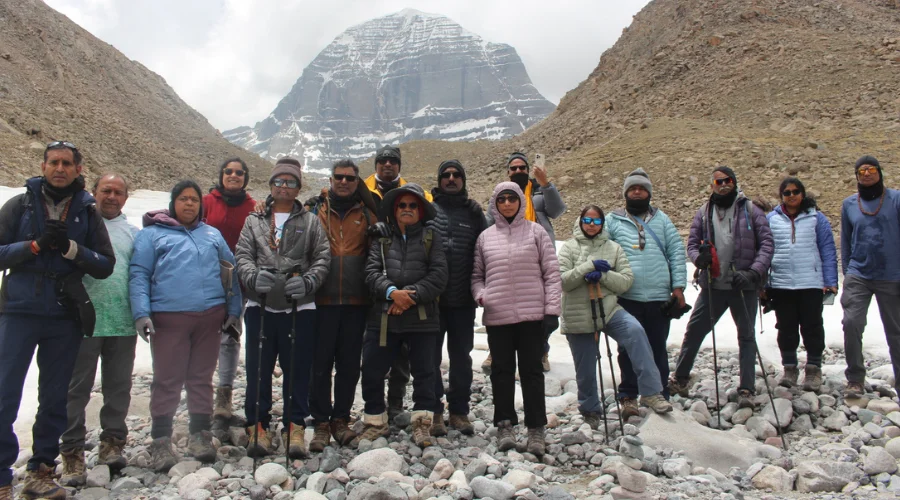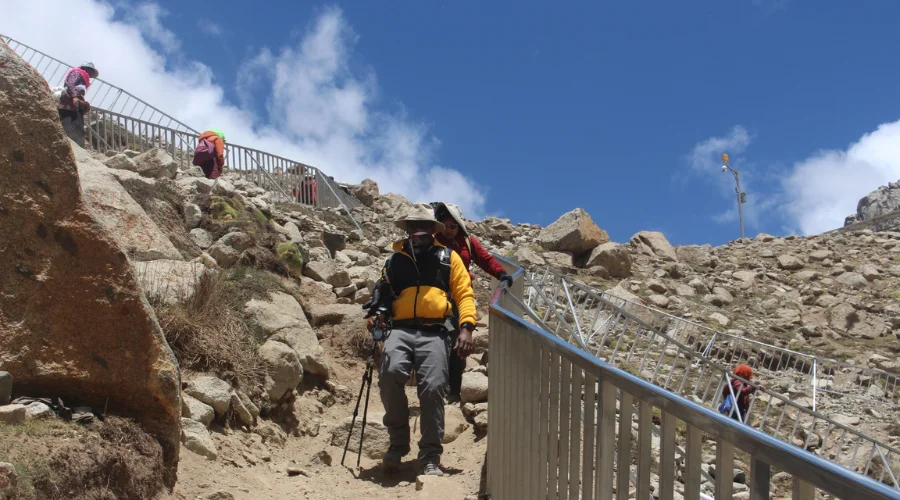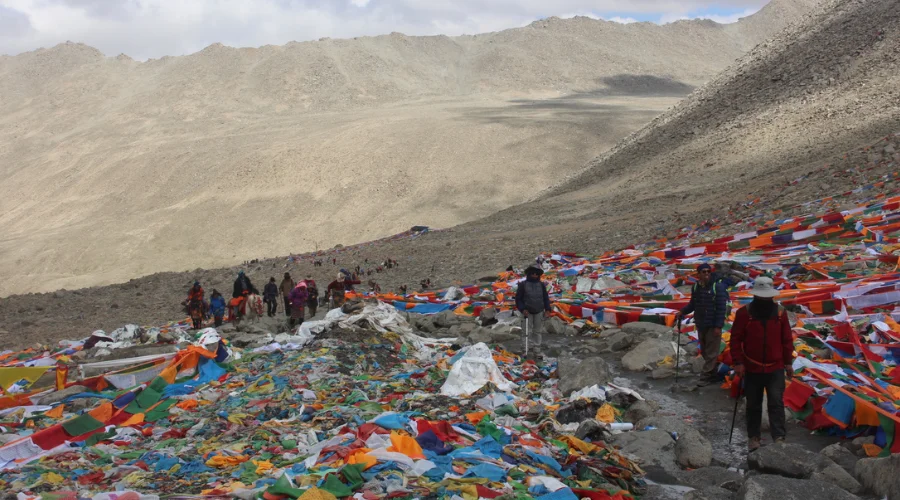Kailash Mansarovar Yatra is a dream among millions of pilgrims and travelers in the world. The Yatra is a religious journey that takes you through some of the most isolated and spectacular scenery on earth.
But with beauty, there is Kailash Mansarovar Yatra difficulty. Kailash Mansarovar yatra is not an easy one, but very rewarding; the high altitude, the long-distance walks, and the unpredictability of the weather make this journey very thrilling.
Many people ask the question, How difficult is Kailash Yatra? We will talk about the challenges, preparation, and how to prepare for and make your Kailash Mansarovar Yatra easier and more pleasant.
How hard is the Kailash Mansarovar Yatra?
The difficulty of Kailash Mansarovar Yatra is moderately challenging to highly challenging. It changes depending on fitness, age and health conditions of an individual. The pilgrimage is a spiritual physical, and mental test.
One of the reasons that makes it Kailash Yatra challenging is the elevation. The Kailash region will be at a height of more than 4,500 meters and the highest point of the trek is Dolma La Pass that is of about 5,630 meters.
Due to heights such as these, oxygen is low, and the air is thin thus complicating breathing. Many of the Yatris who are physically fit develop altitude sickness.
The topography makes it hard, as well. The walk during the yatra is a long journey along rocky roads and steep uphill routes on rocky trails.
Kailash Kora (parikrama) is a three-day walk of about 52 kilometers that pilgrims do where high passes, windy, icy, and bad mountain weather are experienced.
Physical fitness for Kailash Mansarovar Yatra
The Kailash Mansarovar Yatra is rather dependent on physical fitness. The yatra is a long-distance trek with extreme altitudes, with thin air. People who are not diseased can experience fatigue due to low oxygen.
You do not need to be a professional athlete, although you need to be able to walk 5 -7 hours a day, on mountain roads. Strong legs, good stamina, healthy lungs and heart is the most significant.
A person who is inheriting ailments like asthma, heart disease, or high blood pressure is advised to consult the doctor and make an informed decision regarding attending the yatra.
It is recommended to start training in fitness up to 2-3 months before the trip. It can be beneficial to walk, jog, do yoga, and breathe daily.

Another good practice to train your body is to do the actual walk is to do an uphill walk with a backpack on.
There is also the need for mental endurance besides physical strength. The process is not smooth and is very long. With a positive attitude, patience, and determination, the path will be a lot easier and meaningful.
Also, learn more about the Kailash Yatra Significance.
Can beginners do the Kailash Yatra?
Kailash Mansarovar Yatra is not an easy trek that can be successfully done by beginners in the trekking world. Nonetheless, they can join it with the help of adequate preparation.
Numerous amateurs do join the yatra, however. The most significant ones are the gradual acclimatization process, good fitness training and availability of experienced guides.
It can also be simplified by using the helicopter and trek by novice high altitude pilgrims.
Beginners can be encouraged to spend longer periods of rest and acclimatization and focus on the body and mind prior to the yatra.
Difficulty of Altitude Sickness
Altitude sickness is one of the biggest problems of the Kailash Mansarovar Yatra. Low oxygen levels are present in high altitude in the atmosphere, and this can entail headache, nausea, dizziness, and fatigue. It can even fall on experienced travelers.
The danger increases in height above 4,500 meters and the point that is very dangerous is the Dolma La Pass. It is advised to climb slowly, take frequent breaks and be well hydrated.
Drugs like Diamox (with physician guidance) may help to reduce the altitude sickness.
Deep breathing exercises and listening to your body are also very important to learn. In cases where the symptoms are acute, acute reduction of the altitude is the most secure.
Kailash Mansarovar Yatra Age and Health Requirements
There is no age limit for the Kailash Yatra, but most pilgrims between 18 and 65 years old are more comfortable with the pilgrimage.
The elderly travelers will also qualify if they are physically fit, active and medically qualified. Children under the age of 18 are not usually advised as the high elevation can affect them more.
Health conditions are dangerous. People who have issues with their heart, severe breathing problems, uncontrolled diabetes, or high blood pressure should see a doctor and may have to take special precautions.
Even healthy travelers who may get fatigued, dehydrated, and altitude sick will require medical preparedness.
Pilgrims are supposed to bring along the regular medicines, first aid, and some medical emergency supplies. Basic health checks like heart check and a lung check are highly recommended before the yatra.
Most of the pilgrims report that mental strength is more likely to be significant than physical strength to complete the yatra.
Best Time to Visit for an Easy Kailash Mansarovar Yatra
May, June (pre monsoon) and September October (post monsoon) are the best months for Kailash Mansarovar Yatra. At these times the weather is mild, the skies clear, and the trails are not as dangerous.
Summer (July-August) should be avoided due to much precipitation, oily roads and landslides which may slow or jeopardize the trip.
The winters (November-March) are very cold and snow blocks highways, temperatures drop, and accessibility is very minimal; thus, making the trek more challenging.
The selection of the correct season is another factor in acclimatization. Guided by moderate weather, pilgrims can walk without any problems, remain hydrated, and prevent serious altitude sickness.
By visiting during the appropriate time, the traveler can concentrate on the spiritual experience, the scenery and rituals as opposed to dealing with the issue of survival.
How to Prepare for Kailash Mansarovar Yatra Physically and Mentally
The key to a comfortable completion of Kailash Mansarovar Yatra is its physical and mental preparation. It is a long, high, and physically demanding, thus body and mind must be trained.
Physical Preparation:
- Begin to walk at least 5-6 km per day to develop stamina. Increase distance gradually and involve walks uphill.
- Jogging, cycling or swimming help exercise the heart and lungs and this is important at great altitudes.
- Leg, core, and back exercise helps with making it easier to carry a backpack.
- Train walking with a 8-10kg backpack to mimic the conditions of trekking.
- Add breathing exercises or yoga to enhance lung efficiency and deal with thin air.
Mental Preparation:
- The pilgrimage is cumbersome and lengthy. Positivism, patience and determination are essential.
- Realize that facilities are rudimentary, weather may be fickle, and you may have to take rest days.
- It can be mentally trained to walk high, cold nights, and spiritual practices with the help of visualization or meditation.
- Confidence and anxiety can be improved by reading about the experiences of previous pilgrims.
Health Tips:
- Bring first aid kit, routine drugs and altitude sickness medicine only after consulting a physician.
- Train and keep hydrated, eat light and sleep well.
- When appropriate training is obtained, the yatra will be a challenge to manage, and the struggle will be of spiritual value rather than merely physical.
Distance and Trekking Route Difficulty
Depending on the route taken, the Kailash Mansarovar Yatra may be by road or trek or a combination of the two.
Most of the paths begin in Nepal or India and travel through the isolated Himalayan areas, to Mount Kailash and Lake Mansarovar.

The total Kailash Yatra distance is approximately 300-500 km, which comprises road, trekking, and the well-known Kailash Parikrama (Kora) in approximately 52km in 3 days.
The hardest part is the physical one because of its high altitude, rocky roads, and harsh ascents, the Kora.
The most difficult part for most pilgrims is the peak, Dolma La Pass.
Difficulty of the Kailash Parikrama (Kora)
The most physically and mentally challenging aspect of the yatra is Kailash Parikrama (Kora). It is a 52-kilometer circumambulation of Mount Kailash, normally undertaken during 3 days, and has steep ascents, high routes, and not-so-even trails.
The hardest stage is the Dolma La Pass. When one is up there, it is hard to breathe, and cold winds and rocky trails put a strain on one. During this section, pilgrims usually feel tired, have headaches, or some slight altitude sickness.
The Kora must walk long hours a day, sometimes 6-8 hours a day, with a small backpack and necessary equipment. The ground may be flat or rocky and steep, and endurance and leg power are essential.
Weather Problems on Kailash Mansarovar Yatra
The region is in the Himalayas highlands where the weather is subject to sudden changes.
Even during the most optimal seasons, travelers may have to face heavy winds, rain, snow, or extreme cold.
The summit of the route is the Dolma La Pass; it is frequently exposed, the weather may drop drastically, and walking can be made more challenging.
The roads are often slippery, and landslides are frequent during the monsoon months, and during the winter months the trails are covered with snow.
Pilgrims are to expect long days of walking in cold and windy weather, a change in weather may cause the crawling of the process. Good attire, layering and protective clothing are necessary.
Learning about the weather conditions and organizing the yatra during the pre-monsoon or the post-monsoon season will significantly decrease the risks and provide a safe and enjoyable experience.
Dietary and Accommodation Difficulties
Lodging and food along the Kailash Mansarovar route are usually basic. Majority of the visitors are lodged in guesthouses, small lodges or tented camps that are of limited facilities.
The accommodation is simple, heating can be inadequate, and hot water cannot always exist, at least in high places.
Food selections are scarce; food is typically plain, high energy foods such as rice, noodles, bread and vegetables. There is a lack of non-vegetarian choices, and the flavor can be different than that of which travelers are accustomed.
Light eating, carrying snacks, drinking safe and boiled water are also important to keep healthy and energized.
Taking these challenges in stride allows the spiritual and personal sense of the yatra to be ameliorated by the simplicity of the journey.
You can also read the dos and don’ts of Kailash Yatra.
Difference between Road Trip and Trekking Difficulty
The Kailash Yatra is either by road or on foot, or a combination of both.
A road trip is less physically exhaustive since most of the traveling is by automobile.
Nevertheless, the high Himalaya roads may be rough, narrow, and occasionally landslides cover them, which makes the trip long and tiresome.
Travelers contend with altitude, cold, and few stops along the way- difficulties that can exhaust.

The walking trail is a physically challenging one that enables pilgrims to tour the terrain and feel the spiritual force of the mountains.
Though more challenging, trekking can be more fulfilling and inspirational, emotionally and spiritually, to a lot of pilgrims.
Most tourists choose a hybrid strategy, driving long distances and walking in important areas, such as the Kora around Mount Kailash.
The Kailash Mansarovar Yatra Difficulty can be reduced by choosing the Kailash Helicopter Tour.
Medical Aid and Emergency Facilities
There is little medical assistance along the route, particularly in remote areas. Simple first aid is provided in lodges or camps; there are hospitals and sophisticated facilities at a great distance.
The pilgrims are to carry their own drugs, first-aid sets and medicine to counter the effect of the altitude.
The typical health hazards are altitude sickness and cold, dehydration as well as minor trekking injuries.
Emergency medical services, such as oxygen and communication by guides and tour groups are frequent when medical emergencies need a helicopter evacuation are uncommon.
High altitude trekking travel insurance and a pre-travel medical check-up is thus necessary.
How can Senior Citizens do Kailash Mansarovar Yatra?
Kailash Mansarovar Tour can be done by the senior citizens, though proper planning is important.
Physical fitness and health examinations are very vital. Pilgrims older than 60 are advised to visit a doctor, bring medication and not to overexert themselves.
The travellers are typically older and would like to have a road or a mixed way. Additional acclimatization and rest periods have the effect of decreasing fatigue and altitude-sickness.
The life of the yatra becomes transformative to the elderly as they plan, journey at a slow pace and organize their journeys, and the spiritual journey becomes more important than the physical barriers.
Tips to Reduce Kailash Mansarovar Yatra Difficulty
- Exercise Early: It is advisable to start walking, jogging and strength exercises at least 2-3 months prior to the yatra. Practice leg strength, stamina and cardio workouts to manage long walks and high altitudes.
- Adaptation: A day should be spent at intermediate levels before a person goes higher. This aids to minimize altitude sickness and makes breathing easier during steep ascents.
- Select the Optimal Route: Those who are beginners and older citizens are to consider road-based or combination route. It limits the physical tension of extensive trekking portions and at the same time, it does not deprive of the spiritual and aesthetic experiences.
- Pacing: Walk slowly and steadily particularly on the Kora and steep passes. Do not hurry up, have breaks and pay attention to your body in order not to be exhausted.
- Hydrate and Eat Right: Drink lots of water, have light, high-energy meals, and have snacks, such as nuts or energy bars. Correct nutrition keeps your body going on long days.
- Bring Necessary Items: Bring warm clothes, good walking shoes, walking sticks, and waterproof clothing. Dressing correctly will keep you warm during the cold, windy weathers, and against unexpected weather conditions.
- Get Ready Mentally: Be patient and malleable and optimistic. The yatra is characterized by minimal facilities, extended hours and fluctuating weather conditions. With a relaxed but mindful approach to things, things become simpler to manage.
- Go with Professional Guides: Guide services include route finding, speed, and rescue. They also offer moral support which is very helpful especially to beginners or older travelers.
- Keep a close monitoring of your health: Be aware of any symptoms of altitude sickness, fatigue or dehydration. Oxygen usage will be required in case of need and immediate medical attention will be required in case the symptoms deteriorate.
- Plan Rest Days: You should consider rest and acclimatization days in your itinerary. Enough rest will diminish fatigue, enhance endurance and make the journey more pleasurable.
Send an Enquiry
Error: Contact form not found.
© 2025 - Himalayan Trekking and Tours (P) Ltd. All Rights Reserved.

